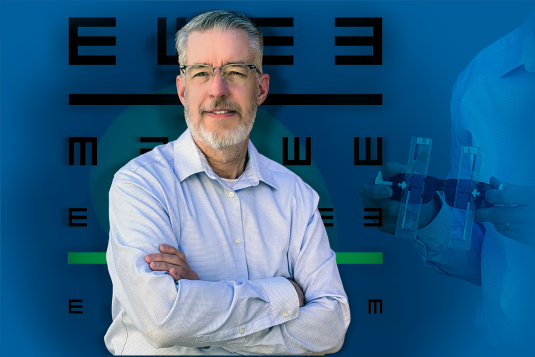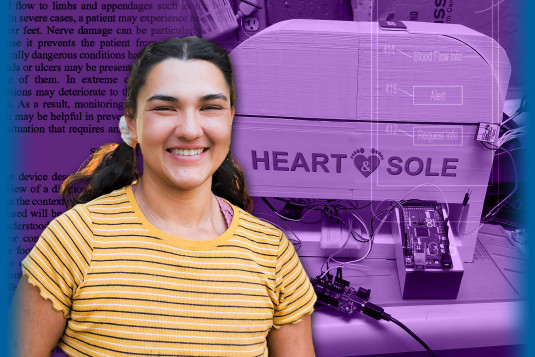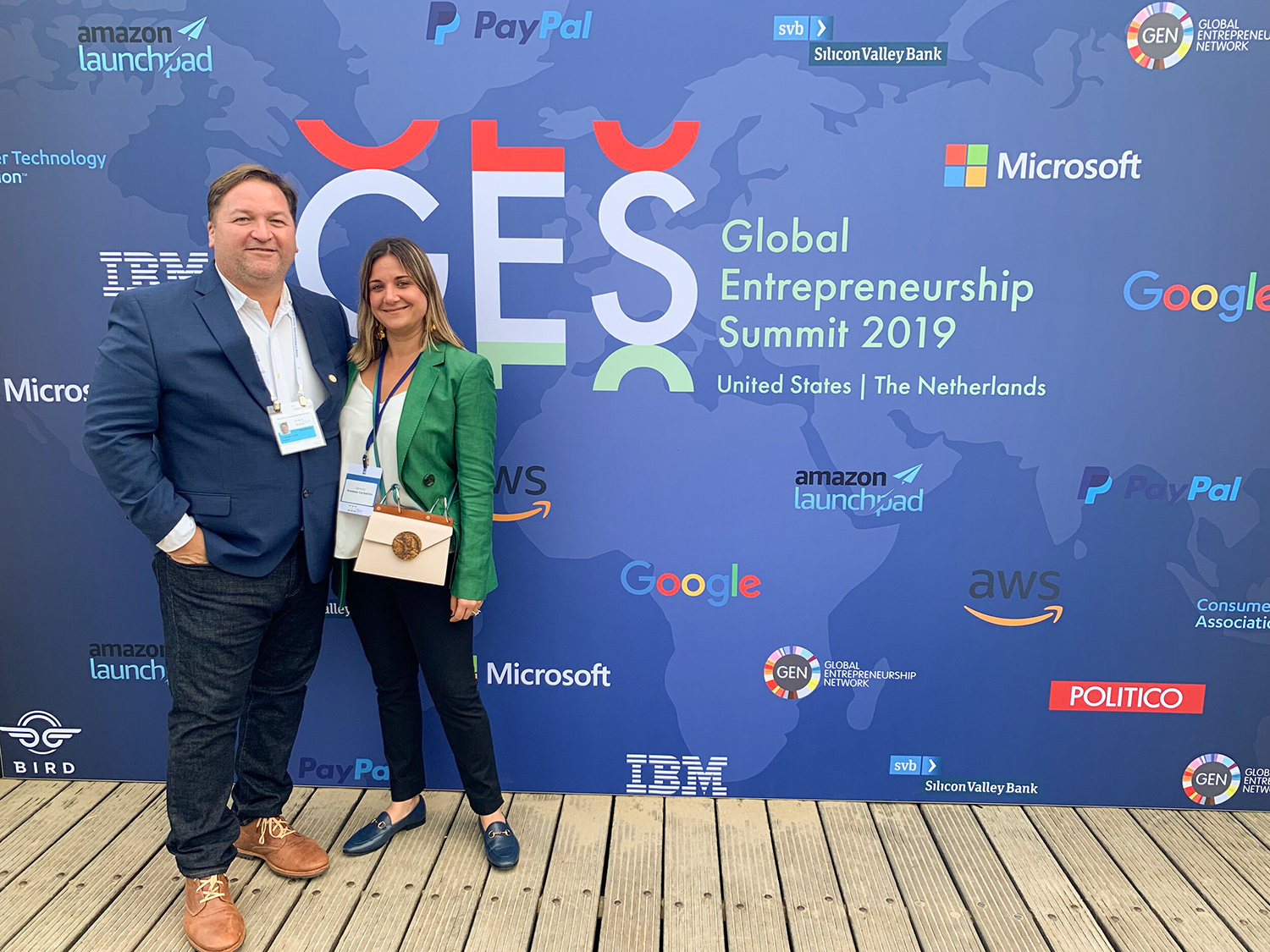
A renewable resolve
When lawyer Vanessa Carballido Clerch and her husband Francisco Laboy Colondres decided to launch a startup in Puerto Rico to address the need for low-cost and reliable energy, they initially played it safe, with Vanessa reluctant to give up the security of her day job. Hurricane Maria further tested her desire to be an entrepreneur. To explain her fears — and her ultimate decision — she remembers a fateful decision her own father made 30 years before.
19 min read
Each month, our Journeys of Innovation series tells the stories of inventors or entrepreneurs who have made a positive difference in the world. This month, Axel Alfaro-Hernandez's story focuses on Vanessa Carballido Clerch and Francisco Laboy Colondres, a married entrepreneurial couple who overcame personal hardships and environmental tragedies to launch a startup aimed at addressing the need for low cost and reliable energy in Puerto Rico.
Do you know an innovator or entrepreneur with an interesting story?
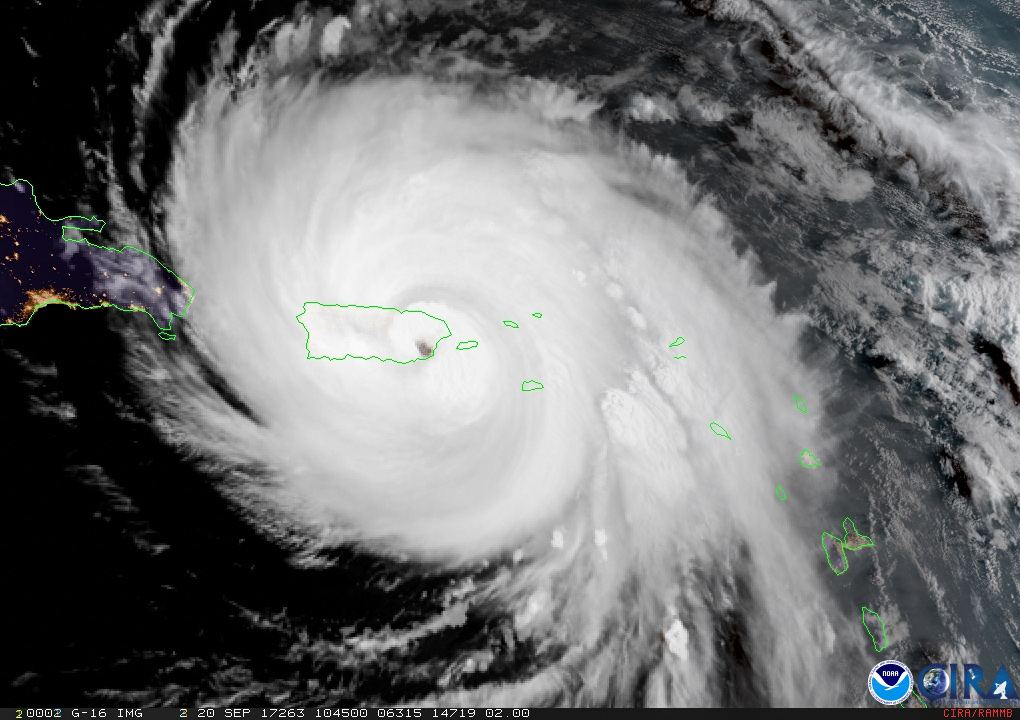
Hurricane Maria struck Puerto Rico on September 20, 2017, causing catastrophic damage to the island's infrastructure, resulting in a major humanitarian crisis.
(Courtesy of NOAA)
The morning of September 20, 2017, as the roar of Hurricane Maria gave way to an ominous silence under an overcast sky, Vanessa Carballido Clerch and her parents made their way down a residential street in Guaynabo, a suburb of San Juan, Puerto Rico, back to the home they had evacuated in the middle of the night.
Carballido Clerch and her husband Francisco Laboy Colondres had decided that she and their 7-year-old son would ride out the storm at her parents’ house in Guaynabo, believing it would be safer than their apartment near the ocean.
But during the night, water started to seep into the house. Carballido Clerch and her cousin ran around frantically unplugging electronics, turning off the breakers, and placing passports and other essentials on tables as the sewage water — identifiable by its repugnant smell — continued to rise. (They would later learn that a drainage pipe had gotten clogged with leaves and debris, causing the sewers to back up.) Furniture and everyday household objects floated throughout the house. Outside, the 155 mph winds pounded the windows and bent the trees. The idea of going out in the Category 4 hurricane was terrifying, but they knew they couldn’t stay inside.
By the time they left the house, the water reached Carballido Clerch’s chest. She held her parents’ dog while her taller cousin carried Carballido Clerch’s son on her shoulders to keep him out of the filthy water. The group formed a human chain, trying to steady each other through the onslaught of the wind and rushing water. Around them they saw flying debris, including loose cables from powerlines that fortunately had stopped working hours before. A neighbor joined them, and they continued up the street to take refuge at another neighbor’s home on higher ground.

Months after Hurricane Maria devastated Puerto Rico, residents struggled to access basic services like electricity and clean water.
(Courtesy of the U.S. Air Force)
After a night of almost complete disconnection from the world — phone towers had lost power during the hurricane — the Carballido Clerch family, like many in Puerto Rico, walked out on that September 20, 2017, morning unaware of the shocking extent of damage they would face.
Over the following months, the complete collapse of the island’s infrastructure would lead to a profound humanitarian crisis, with a death toll that would rise to 2,975 as the extended lack of power negatively impacted critical facilities like hospitals and nursing homes.
The waters had receded, but Carballido Clerch’s parents had lost everything. Their furniture, their appliances, their electronics, their two cars — all destroyed. All of their personal belongings had become trash to collect in bags and pile up on the curb for garbage collectors. Carballido Clerch spent the next month with her parents, throwing out everything they had owned, painstakingly cleaning the house to make it livable again, and patiently salvaging what they could.
For any family, this would’ve been an indescribable loss. Adding to the pain, most of the few treasured belongings they had been able to bring from Cuba three decades earlier were among the items destroyed: photo albums; old books, including first editions of books authored by her grandfather — much of their history had been washed away by the storm.
The items that survived, laid outside to dry under the sun, included a few pictures. One is the last photograph taken of the family together in Cuba, sitting around a table at a famous Habana restaurant called La Bodeguita del Medio. Strikingly, though the picture is from the early 1990s, it’s in black and white, as if decades had passed between it and the family photos taken only a few years later in Puerto Rico — as if they were two different lifetimes.
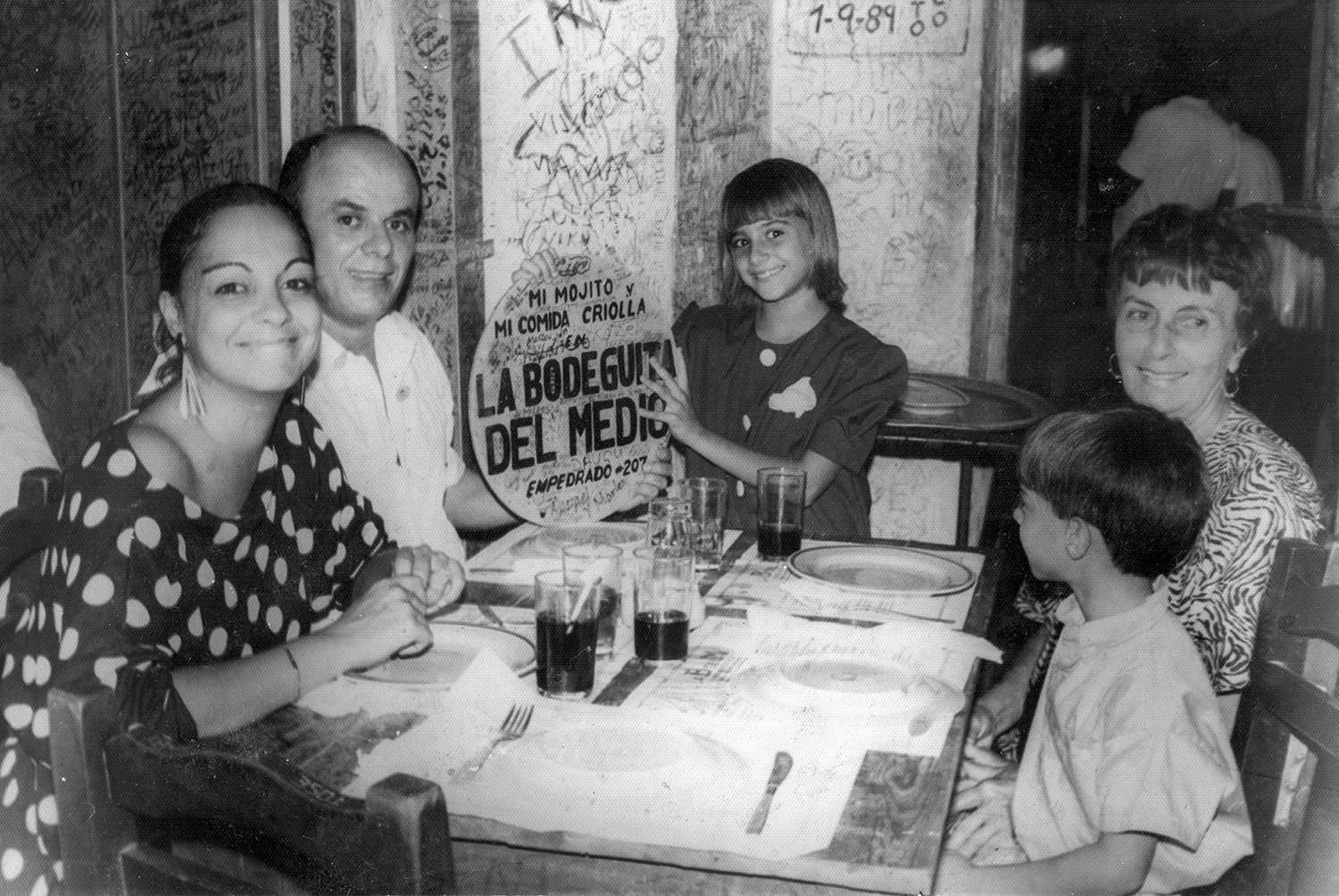
Vanessa Carballido Clerch's family celebrates her 10th birthday at a restaurant in Havana, Cuba in the 1990s. "La Bodeguita is one of the most famous restaurants in Havana. [Ernest] Hemingway used to be a regular. I remember I had the masas de puerco fritas," she said about the photo. Pictured from left to right: Norka Clerch, her mother; Jorge Carballido, her father; Vanessa Carballido Clerch; Hilda Pérez, her paternal grandmother; and José M. Carballido Clerch, her younger brother. (Courtesy of Vanessa Carballido Clerch)
Carballido Clerch’s father, Jorge, had fled Cuba for Puerto Rico in 1991, convinced that his family would have a better future there.
Now, as they became aware of the extent of the damage across the island, Carballido Clerch said she wondered if she would have to leave everything, too. During the past year, she and Laboy Colondres had been trying to launch a renewable energy startup. Like many Puerto Rican families, they had high energy bills to pay every month. According to the U.S. Energy Information Administration, households in Puerto Rico pay much more per kilowatt-hour than in the States, businesses pay just over double, and industries, almost triple. On an island with, at that time, 44% of its residents living below the poverty line, an almost 12% unemployment rate, and a steadily declining population, energy costs hindered the ability of existing and new businesses to succeed and impacted the island's ability to attract new businesses and industries.
Laboy Colondres and Carballido Clerch said they thought they could create something to address this problem. They envisioned a business that would provide an alternative to the expensive island grid, supplying customers with microgrids, or small-scale, local energy systems that most often — around 90% of the time — rely on renewable sources such as solar, wind, or hydro energy. Microgrids can power one building, such as a home or a school, or several, like a neighborhood or an industrial park. They can even connect with each other, creating networks of decentralized energy grids that can power whole communities.
Typically, however, microgrids are also connected to an area’s main grid and mainly used for what is known as “net metering”— to export energy to the main grid in exchange for tax credits. Some of these systems are only expected to operate independently in the event of a blackout, and some even lack batteries for energy storage and are completely useless without the main grid, leaving some homes with expensive solar energy systems as dark as their neighbors’ during power failures.
Laboy Colondres, a telecoms engineer, said he believed that recent advances in battery technology, particularly the advent of lithium batteries, would allow them to distinguish themselves from competitors by offering completely off-grid solutions. Using this technology, they could disconnect their customers from the expensive main island grid and make them entirely self-sufficient. Laboy had already created and sold a company once. Carballido Clerch, as an intellectual property (IP) lawyer who had helped entrepreneurs and innovators protect their ideas, was also drawn to the idea of creating something of her own and of doing something that directly improved people’s lives. But she had concerns about the risk, since neither of their backgrounds was in energy development.
“Francisco is not risk-averse at all, he has that capacity to be bold. But I'm not.”
She said she contemplated the security she would be giving up with her job, including her health insurance, 401(k), and a steady salary.
As Carballido Clerch sees it now, part of her cautiousness was also rooted in her personal history.
The years that followed her father’s defection from Cuba were tough for the whole family. His medical license was not accepted in Puerto Rico, so, after practicing medicine for over 20 years, he had to re-enroll in medical school and eventually pass licensing examinations again. While her father completed his second medical residency, the then 13-year-old struggled to adapt to her new home.
“I didn't have any friends. All my friends were [in Cuba], my cousins were there,” Carballido Clerch said.
She also recalled the challenge of taking English courses for the first time.
“I was a really good student, but I didn't speak an ounce of English,” said Carballido Clerch.
While most of her classmates had been studying English since preschool and spoke the language fluently, she had to read the literary texts with a dictionary always by her side. They also didn't have a computer at home, so she typed all her school papers with a typewriter. When Carballido Clerch made a mistake, she retyped everything, afraid her teacher would penalize her for handing in work with hand-made corrections that her classmates never needed to make.
In that way, Carballido Clerch and her father shared the experience of having to make double the effort of their peers for the same result. She said those experiences made her extra cautious, and they approached the business endeavor very warily at first. Carballido Clerch kept her day job as an IP lawyer while learning about the renewable energy industry during her free time. Like that 13-year-old taking her first English courses years back, she was hitting the books to patiently learn something unfamiliar to her.
Still, by early September 2017, Carballido Clerch and Laboy Colondres were already in contact with companies that provided solar panels and batteries. When Hurricane Irma tore through the Caribbean but left most of Puerto Rico comparatively stable — passing north of the island with peak winds of 55 mph — they were able to persuade some of these companies to donate equipment to send to Saint Martin and the British and U.S. Virgin Islands, all devastated by Hurrican Irma.
But by the time those donations were about to arrive, only a few weeks later, Hurricane Maria came, and everything changed. Suddenly, fulfilling the simplest needs in Puerto Rico — let alone trying to launch a business — required extraordinary effort and time. Would they need to forget about their startup? Many Puerto Ricans were fleeing the crisis and moving to the States, where Carballido Clerch and Laboy Colondres had both lived before and were confident they could get good jobs. Would she, like her father, leave the island she had come to think of as home?
“We sat down and we had to have a very honest conversation about whether we wanted to stay in Puerto Rico and see this through. That really put our desire to be entrepreneurs and our faith — in ourselves and what we wanted to do — to the test.”

Genmoji, a renewable energy startup, trademarked their company's portmanteau name.
But her father had also demonstrated that embracing uncertainty and working hard for the promise of a better future was worth it. And she already knew she had it in her to adapt. They felt that their startup was needed now more than ever for the people of Puerto Rico, so they set out to work.
The months after Maria turned into what news media described as the worst blackout in U.S. history, with power restored to most of the island very slowly over many months. But during that time, partnered with nonprofits and NGOs, Carballido Clerch and Laboy Colondres helped install more than 200 microgrids around the island, mostly in remote areas in the countryside, providing electricity to communities that otherwise may not have gotten power for a long time. The urgency of this relief work also turned out to be vital training, helping them gain quick experience, what Carballido Clerch called their “baptism by fire.” Their company, Genmoji, was officially born.
They started using the name during those months of relief work. Carballido Clerch and Laboy Colondres wanted a name that was not only catchy and marketable, but likely to be trademarked.
“For me personally, coming from an intellectual property background, and for us as a company, it was very important to utilize the tools that IP law in the U.S. gave us,” she said.
She said they needed a name that was “arbitrary and distinctive” within their market, so that the United States Patent and Trademark Office (USPTO) wouldn’t initially refuse trademark registration for a likelihood of confusion.
The name was proposed by Laboy Colondres, as a portmanteau of “generation” — a double meaning: the production of energy and the noun that refers to groups of people born during the same time period — and “emoji,” as a playful allusion to how we perceive others in the digital world.
“We wanted to brand ourselves as a company that wanted to change the generational perception and lead toward a cleaner, more renewable future... [the name] has served us amazingly.”
Both co-founders described how people would recognize their company trucks and inquire about the business’ origin due to its unique name.
“It is a name that sticks with people. [It] illustrates the power of a trademark, and how important it is to pick the right trademark,” Carballido Clerch said.
After a few months, as people saw their branded Genmoji trucks around the island and word got around about them, they started to hear from potential paying customers. Due to the company’s public exposure, they signed their first client in April 2018, but would continue doing some relief work for a few more months.
“We started as an integrator, as just a regular company that installs solar panels, storage, and batteries,” Laboy Colondres explained.
That didn’t mean that they weren’t innovating.
Though integrators like Genmoji source their equipment from manufacturers, part of their job is engineering design — figuring out how to select and integrate the different components of the microgrids they will install, such as solar panels and batteries, to get the most efficient results from the expected climatic and atmospheric conditions. From the beginning, Laboy Colondres developed formulas that he considers more suited to the environment of the island, and to completely off-grid systems like Genmoji’s, than those produced by existing software tools. They consider these formulas trade secrets, and Carballido Clerch has built their protection into their business contracts.
As an IP lawyer, Carballido Clerch understands the importance of owning their own products.
“We wanted to innovate, not just install systems,” she explained. “So we started looking for areas where we could innovate within the renewable energy space.”
At first, they worked on energy efficiency exchanges, thinking of ways for energy companies to provide updates to smart devices connected to their grids to make them more energy efficient, and for smart devices of the same model to learn acquired efficiencies from each other.
“The desired outcome would be for a significant number of smart devices to create a unified energy efficiency during peak times, resulting in a substantial energy consumption reduction that would help a grid operator meet federal emissions and energy consumption mandates,” explained Laboy Colondres.
They submitted their energy efficiency exchange project to the 2019 Global Entrepreneurship Summit in The Hague — an event organized by the U.S. Department of State and the Netherlands’ Ministry of Economic Affairs — and were among about 700 companies accepted. The event allowed the selected companies to exhibit their services, find opportunities for collaboration with other startups around the world, and have one-on-one meetings with CEOs and high-level personnel of some of the largest companies in the world.
Carballido Clerch and Laboy Colondres got to pitch their idea to a few Fortune 500 CEOs. During one of those conversations, Kees Koolen, founder and CEO of Koolen Industries, an investment company in the field of clean tech, showed interest in the ongoing energy situation in Puerto Rico. That conversation helped them find “the right problem to tackle,” explained Laboy Colondres. They realized that they were more interested in the problem of the intermittency of renewable energy, an issue often cited by critics of renewable energy because sources like wind and solar don’t generate energy around the clock. They decided to work on reducing the interruptions in energy production when using renewable resources. Koolen offered them his support as a consultant and advisor.
Since 2019, Genmoji have been developing their own wind turbine, one that can power communities and commercial and industrial buildings — what they call a microgrid turbine, because of its substantially smaller size. After two and a half years, their latest prototype is almost ready to be taken to market. The pair have funded their research and development themselves, from the earnings of the integration side of the business.
“Having to [invest] our own money really was a challenge, and you really have to believe in what you are doing, because it's your own resources that you are putting into it,” Carballido Clerch said. “Especially in Puerto Rico, where you don't have the Silicon Valley structure for startups, it's really hard to raise funding, it's really hard to even be attractive to venture capital or investors.”
Carballido Clerch and Laboy Colondres said they plan to file for a patent for their new wind turbine soon, initially in the United States and later in Spain and Mexico. They are also going to apply to trademark the name of that product. The pair already have two registered trademarks: in addition to their company name, they have trademarked Airmoji, the brand name of an earlier iteration of their microgrid turbine.
“IP is a huge component of what we do, and we are very zealous of our IP protection.”
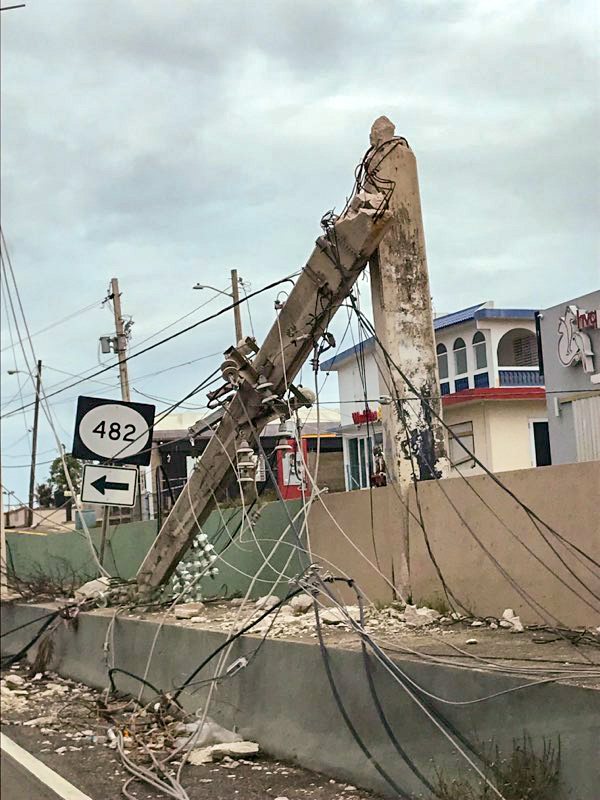
The electrical infrastructure system in Puerto Rico has been damaged repeatedly by hurricanes. Home-grown renewable energy company Genmoji is providing microgrid technology, including wind turbines of their own design, to help residents stay powered.
(Photo by Jeff Miller, Courtesy of Western Area Power)
The turbine will soon undergo performance testing in Tarifa, Spain — a region known for extreme winds — to see how it endures sustained strong climatic conditions. Ideally, it will prove strong enough to withstand future hurricanes, in Puerto Rico or elsewhere.
One principle that has guided Carballido Clerch and Laboy Colondres is that recovery efforts alone don't address underlying, structural problems. Following the hurricane, reconnecting people to the expensive and unreliable main electric grid was always only a temporary solution. Hurricane Maria showed the danger of relying on that grid, and last year, on September 18, Puerto Rico was hit by another hurricane, Fiona.
Carballido Clerch and Laboy Colondres want to make a significant, lasting impact, and they believe one way to do that is to help usher in the creation of energy cooperatives, decentralized systems in which communities with standalone but interconnected microgrids can generate their own energy, sharing production among all users, instead of depending on a power plant miles away.
“In this way you are creating extensive energy resilience, creating what are called virtual power plants, where if one sector runs out of energy, you can then depend on other sectors to energize it immediately, and this happens without anyone noticing,” Laboy Colondres explained.
He believes that a great advantage Puerto Rico has in creating this model is the presence, all around the island, of pharmaceutical manufacturing plants and factories owned by multinational companies with AAA credit. According to Laboy Colondres, these companies often have very ambitious environmental stewardship goals, which require them to move toward almost complete use of energy from renewable sources, either by producing it or through purchase.
Genmoji even provide what they call a forced-air recovery solution: their wind turbine can be installed at the end of exhaust vents, to be powered by the air coming out of machines such as industrial chillers and air conditioners.
“By recycling the energy back into those sources of cold or heat, those [buildings could become] 100% energy neutral,” Laboy Colondres said.
“We see a great potential in this model of pharmaceutical plants within a town being the main off-taker of the energy that is produced throughout that entire community. In other words, that the entity agrees to buy all the surplus electrons from each house, each business, each government building, because it needs them. This then provides a credit to each user of the grid, which becomes the energy subsidy, making energy much more cost-effective,” he explained.
And creating these good communities with great energy infrastructure in turn would attract more companies, so energy cooperatives that start off with one big energy off-taker could grow to include multiple businesses both buying and producing energy, making the entire model much more viable and cost-effective.
"Right now, all the pharmaceutical companies and big multinational factories here are investing in co-generation,” said Laboy Colondres.
He points out that, unfortunately, as more companies go off-grid, LUMA Energy, the company that currently manages Puerto Rico’s power and has continually increased energy costs for Puerto Ricans since taking over in 2021, will see their market share go down, and continue to increase prices.
“The process of rebuilding the electrical grid in Puerto Rico has been quite bumpy. A little more than $2 billion have been spent, and honestly the concentration of those improvements has been around the metropolitan area,” said Laboy Colondres, explaining that, on most of the island, the network is very weak.
Because of those rising costs and the continued weakness of the grid — the frequency of blackouts increased when LUMA took over — interest among Puerto Ricans in going off-grid continues to rise, though not all can afford it.
So far, Genmoji has only been involved in public microgrid projects for communities. But the company is about to close its first larger microgrid project with a private entity, a good sign that the founders’ larger vision — that energy cooperatives would be accessible to even underserved communities — could be closer to reality.
Carballido Clerch and Laboy Colondres also work with the nonprofit Solar Libre, which provides training and certifications for women to learn to install grids and start their own solar energy businesses. Genmoji regularly hires women from Solar Libre’s apprentice program, providing them with the hands-on experience they need to earn their certifications.
By deciding to stay in Puerto Rico and start their business, it’s possible that Genmoji's founders have made it easier for other people and businesses to do the same. Carballido Clerch knows that it’s still not easy.
“The two things that have made me grow most as a person have been being a mother and birthing a company. It really tests your limits in all senses, you run the gamut of emotions, it frustrates you… it's very fulfilling but it's very challenging, especially those first few years. It really tested my capacity to withstand risks, and changes, and roll with the punches, and learn how to fail, because nobody teaches us to fail.”
But she has encouraging words for people who fear the risks of launching a new venture.
“I think we need to debunk that myth, that being an entrepreneur doesn't lead to good things, to stability, by saying, yes, you can do it. If I did it, and I'm incredibly risk-averse, anyone can do it,” Carballido Clerch said.
Credits
Produced by the USPTO’s Office of the Chief Communications Officer. For feedback or questions, please contact inventorstories@uspto.gov.
Story by Áxel Alfaro Hernández. Additional contributions from Whitney Pandil-Eaton and Jay Premack. Special thank you to Vanessa Carballido Clerch and Francisco Laboy Colondres.
References
National Hurricane Center and Central Pacific Hurricane Center - National Oceanic and Atmospheric Administration. “Hurricane Maria”. https://www.nhc.noaa.gov/archive/2017/al15/al152017.discus.018.shtml
Lynch Baldwin, Sarah, and David Begnaud. “Hurricane Maria: Death Toll in Puerto Rico Much Higher, Estimated at 2,975, New Study Finds.” CBS News, August 29, 2018. https://www.cbsnews.com/news/hurricane-maria-death-toll-puerto-rico-2975-killed-by-storm-study-finds/.
U.S. Energy Information Administration. “Puerto Rico Territory Energy Profile.” https://www.eia.gov/state/print.php?sid=RQ
Glassman, Brian. “A Third of Movers From Puerto Rico to the Mainland United States Relocated to Florida in 2018.” Census.gov, September, 26, 2019. https://www.census.gov/library/stories/2019/09/puerto-rico-outmigration-increases-poverty-declines.html.
Federal Reserve Bank of St. Louis. “Unemployment Rate in Puerto Rico,” May 23, 2023. https://fred.stlouisfed.org/series/PRURN.
Acevedo, Nicole. “2020 Census Overcounted People in Puerto Rico, Hinting at Larger Population Loss.” NBC News, August 17, 2022. https://www.nbcnews.com/news/latino/2020-census-overcounted-people-puerto-rico-hinting-larger-population-l-rcna43384.
Masterson, Victoria. “What Are Microgrids – and How Can They Help with Power Cuts?” World Economic Forum, May 20, 2022. https://www.weforum.org/agenda/2022/05/what-are-microgrids-renewable-power/.
Fenn, Larry. “Puerto Rico Issues New Data on Hurricane Maria Deaths.” NBC News, June 13, 2018. https://www.nbcnews.com/health/health-news/puerto-rico-issues-new-data-hurricane-maria-deaths-n882816.
Acevedo, Nicole, and Gabe Gutierrez. “As Puerto Rico’s Power Crisis Worsens, Lawmakers Probing Outages Seek Answers.” NBC News, October 14, 2021. https://www.nbcnews.com/news/latino/puerto-ricos-power-crisis-worsens-l…;


